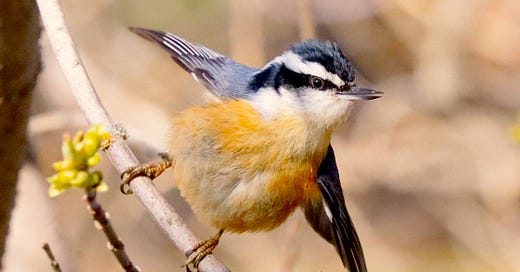Red-breasted Nuthatch, doing its tiny penguin impersonation
Field notes from a stream-side thicket
Hawthorn is hard on my bicycle and hard on my skin. Specifically as to the bicycle, it’s hard on the tires. I prefer not to use my car when a bicycle will do, but bicycles are easier to steal, so I often hide mine in riparian hawthorn stands and lock it to one of the trees. The thorns are incredibly strong and sharp, and I’ve had at least two tire punctures because I wasn’t careful enough.
There’s not much I can do about my face though. The opportunity for a good photograph can vanish in the blink of eye, so I’m often in a rush to create an angle and secure line of sight. From that process my face sometimes looks like I’ve been too close to a cat fight. At least I’ve reached an age where I’ m used to laughing at myself in a mirror. A minor wound is a fair price for a good photograph. Usually.
The Kingfisher
A couple years ago, at a gallery in east Spokane, I had a chance to visit with Marina Richie, the author of Halcyon Journey, in Search of the Belted Kingfisher. I laughed as we compared notes on how difficult it is to get close enough to a kingfisher to get a photograph, let alone a good look. One of the things I learned from her wonderful book is that kingfishers (who possess incredible vision) will alter the size of their catch to match the size of the offspring they must feed, before the kids can fly on their own. Kingfishers remain mercurial, but I’ve had better luck since.
Flickers
Northern Flickers are the most visible woodpeckers in our region in part because (for reasons I can’t help you with) they enjoy hammering on chimney flashing. That can be very loud, and really annoying. In the actual wild, they have a piercing call and a good thwack of a knock on wood. They’re a challenge to photograph and the prized shots are those that capture the brilliant, orange flush of their wings in flight. The males also have orange streaks on their faces.
Magpies and hawks
I’ve spent enough time with Black-billed magpies this winter and spring that I know that they know of me. They’re among the smartest of animals and beneath their raspy primary calls, have a rich language of squeaks and rhymes, and even a frog-like croak. In direct sunlight their darker feathers are iridescent. It’s hard to see this with the naked eye, but the camera can freeze the action in a small fraction of a second. I’ve been lucky to observe and at least try to photograph the interactions between magpies and hawks in recent weeks, specifically with a couple Rough-legged hawks that rouse the interest of magpie parents. I’ve not witnessed any wing-to-wing combat, but when the hawks show up near a nest, the magpies will park nearby, sometimes just a few feet from the hawks. The hawks are unsettled by this, and usually leave the scene.
To continue viewing this post, and access the entire Rhubarb inventory, please become an annual subscriber to The Daily Rhubarb at the link above—tjc














Great Nuthatch shot...